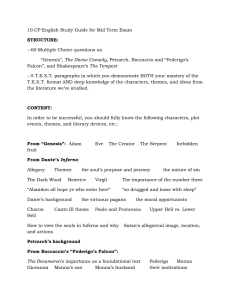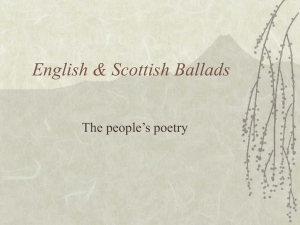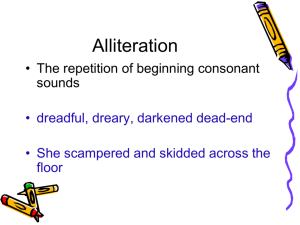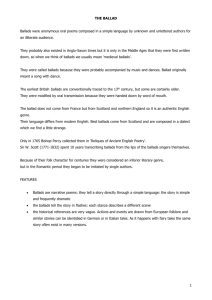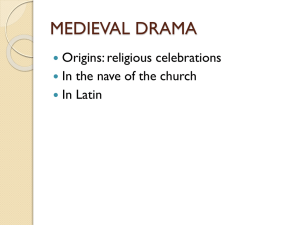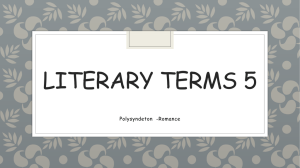Background - TeacherWeb
advertisement
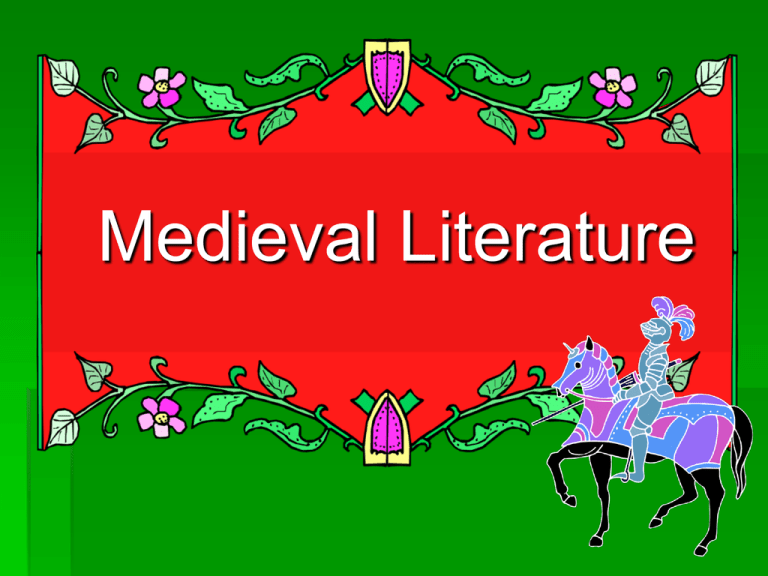
Medieval Literature Federigo’s Falcon Federigo’s Falcon Author: Giovanni Boccaccio (1314-1375) Genre: Short Story; Frame Story Source: Decameron – A collection of 100 stories using the literary device of framing; Chaucer imitated Boccaccio’s frame structure in The Canterbury Tales. Importance: Reveals medieval attitudes about love, marriage, chivalry, and separation between classes. Background: •Begins with a description of the Bubonic Plague (specifically the epidemic that hit Florence, Italy in 1348). •Leads into an introduction: 7 young women and 3 young men flee plague-ridden Florence to a villa in the countryside for two weeks. •To pass the time, each character tells one story for each night at the villa. Fourteen days pass but two days each week are set aside: one for chores and one holy day. •100 stories are told by the end of the ten days. (Decameron = “10 days”) Background (cont’d): •Each character is “King” or “Queen” for one of the ten days in turn, to choose the theme of the stories for the day. •Each day includes a short introduction and conclusion describing the day’s activities. (Framing) •In the whole of the collection, Boccaccio imitates a variety of previous material and forms. His stories mock the greed of the clergy, reveal tensions between classes, and portray the perils and adventures of travel. •Topics: power of fortune; the power of human will; love tales that end tragically; love tales that end happily; tricks that people play on one another; stories of virtue. Summary: Monna Giovanna’s son becomes seriously ill and asks his mother for one thing only to make him happy—Federigo’s Falcon. Monna goes to Federigo’s farm to ask for it. Because Federigo has nothing to serve so great a woman (with whom he has been in love), he roasts his beloved falcon & serves it to her. He learns the true purpose of her visit too late, & soon after, the child dies. After a period of mourning, Monna is urged to remarry & finally gives her heart to Federigo. Man sells all he has for true love; when she is at his house he even cooks his prized falcon to serve her. Ironically, she has come to beg him for the falcon for her dying son. Precursor to “The Gift of the Magi” by O. Henry, has been used many times in tv shows especially Christmas ones 7 Ballads Author(s): English Commoners; Unknown Genre: Ballads (Folk Ballads) are narrative poems originally intended to be sung; usually focus on a single incident; begin abruptly; use dialogue (& dialect), repetition, and quatrains (four-line stanzas). Rhyme scheme is often abcb or aabb. Source: Oral tradition; Minstrelsy of the Scottish Border by Sir Walter Scott Importance: Offer a glimpse of the lives of “ordinary people.” They are the “true songs of the people.” Subjects include: tragic love, domestic conflict, crime, war, and shipwreck. Background: •No one knows when the first folk ballads appeared in Britain; probably during the 12th century. •Unwritten; passed along orally for many centuries. •Most of the earliest ballads we know of probably date from the 15th century. At that time, no one paid much attention to them as literature. •1765, Bishop Thomas Percy published Reliques of Ancient English Poetry. This helped ballads come to be recognized as a part of Britain's literary heritage. •Sir Walter Scott, author of Ivanhoe, was influenced by Percy's Reliques. Scott often traveled to the Scottish-English border region to collect material on the subject. His Minstrelsy of the Scottish Border, published in 1803, is a pioneer work of scholarship on the background and variations of Scottish ballads. Background (cont’d): •“Barbara Allan,” “Sir Patrick Spens,” and “Get Up and Bar the Door,” originated in this wild, rugged border country between England and Scotland. Their language is the Scots dialect of English. • As they were passed along from person to person, place to place, and generation to generation, the ballads often acquired new words and new verses. •No such thing as a “standard version” of a folk ballad, because every balladeer feels free to make alterations. Literally hundreds of versions of "Barbara Allan" have appeared in print. Folk ballads, with their familiar melodies, are truly songs of the people. •Later writers, including Sir Walter Scott, produced literary ballads in imitation of the traditional ones. Few literary ballads have had the power of the old folk ballads to capture and hold the imagination Summary of “Sir Patrick Spens”: This tragic ballad describes the loss at sea of a Scottish ship, its commander, and the crew. The king needs a good sailor and is told by an elderly knight, “Sir Patrick Spens is the best sailor / That sails upon the sea.” When Sir Patrick receives word, he is upset because it is not a good season for setting sail (most likely winter or early spring—full of storms). He submits to the king’s will, however, and he and his crew all die at sea. Summary of “Get Up and Bar the Door”: This humorous ballad tells the story of a strong-willed husband and wife who are both so stubbornly locked in argument that they ignore common sense as well as danger. On a windy night, the husband tells his wife to “Gae out and bar the door.” She replies by saying she’s too busy with chores and that “It’s no be barrd for me.” They made a deal that the first person to speak had to go shut the door. At midnight, two burglars arrive. They eat the couple’s food and then threaten to shave the husband’s beard off while the other kisses the wife. When they find no water to use to shave the man’s beard he finally speaks up in protest. The wife then happily responds by pointing out that he’s said the first word and has to get up and go bar the door!

